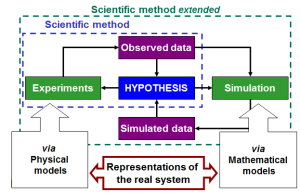Building Cognitive Structures
The how-to procedural learning (carrying out a series of steps) in Simulation helps learners recall or acquire a cognitive structure to organize new knowledge (Merrill, 2009, p. 51). Simulation makes use of Merrill’s First Principles of Instruction to help reinforce this structure and build knowledge: Demonstration (guidance, peer demonstration); Application (coaching, feedback); Integration (reflection); Activation (recall, describe, demonstrate prior knowledge) (Merrill, pp. 42-56)
Significance to Social Context, Communities of Practice, and Other Adult Education Approaches
As well as building skill and knowledge in physical or conceptual systems, the Learner-Centred approach inherent in Simulation helps learners develop skills in social context within communities of practice. Skills developed in Simulation may apply to other adult education instructional approaches, such as problem-based learning and reciprocal teaching. For example:
- dynamic, ever-changing patterns of communication, emphasize participant roles and sharing of initiative within groups (Gibbons, McConkie, Kyeongju Seo, Wiley, 2009, p. 179)
- patterns of communication develop among learners, instructors and instructional agents; in reciprocal learning, for example, pairs of students act as “teachers” or instructional agents for one another
- adult learners use reflection, peer critique, and public demonstration of new knowledge or skill, to relate general information to specific, and reinforce learning (Gibbons, McConkie, Kyeongju Seo, Wiley, 2009, p. 179).
Simulation in Online or Hybrid Instructional Delivery
Increasingly, adult learners are acquiring skills through online or hybrid instructional delivery via simulated or virtual (computer-mediated) environments in a variety of professions where significant risk may be associated with the skills or activities practiced, for example:
- Healthcare – medical simulations used in training and assessment of health professionals
- Pilots, Astronauts, Maritime Captains, Nuclear Plant Operators – simulations used in training and assessment
“Simulations can be used in the arts as well as the sciences—to experiment with stage sets, stage lighting, and museum displays without investing real-world dollars to build things that will eventually be discarded. Simulation technologies can be used by engineers, architects, and scientists to test everything from the identification of potential new drugs to discovering the impact of wind velocity on a yet-to-be-built skyscraper” (Damassa & Sitko, 2010, p. 7)

Source: Donatello, M. Wikipedia, 2008. http://en.wikipedia.org/wiki/File:Modeling_in_science.PNG
- Engineering – Modeling and Simulation (M&S) – used to test how something will behave without testing in real life; e.g. computer simulation to “test” effect of a design change on a car; also systems engineering (e.g. military systems)
- Scientific research – simulation used to extend the scientific method to test a hypothesis via mathematical model rather than physical model